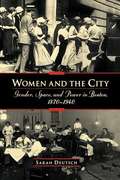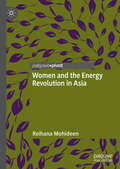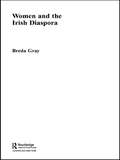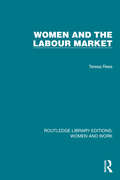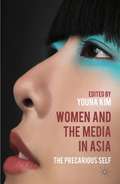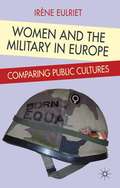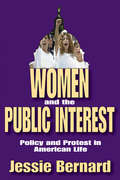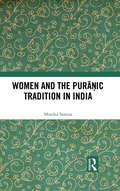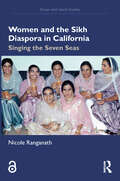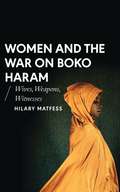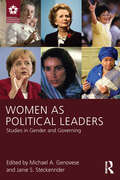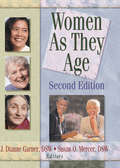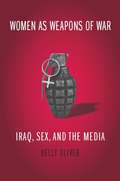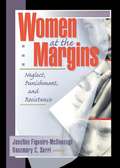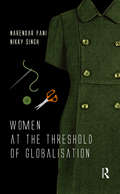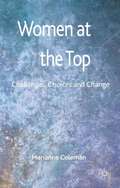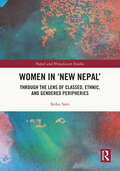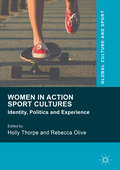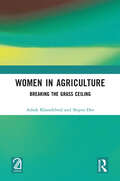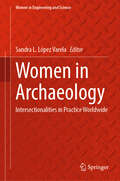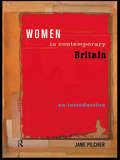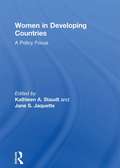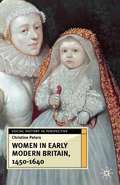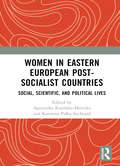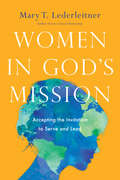- Table View
- List View
Women and the City: Gender, Space, and Power in Boston, 1870-1940
by Sarah Jane DeutschIn the 70 years between the Civil War and World War II, the women of Boston changed the city dramatically. From anti-spitting campaigns and demands for police mothers to patrol local parks, to calls for a decent wage and living quarters, women rich and poor, white and black, immigrant and native-born struggled to make a place for themselves in the city. Now, in Women and the City historian Sarah Deutsch tells this story for the first time, revealing how they changed not only the manners but also the physical layout of the modern city. Deutsch shows how the women of Boston turned the city from a place with no respectable public space for women, to a city where women sat on the City Council and met their beaux on the street corners. The book follows the efforts of working-class, middle-class, and elite matrons, working girls and "new women" as they struggled to shape the city in their own interests. And in fact they succeeded in breathtaking fashion, rearranging and redefining the moral geography of the city, and in so doing broadening the scope of their own opportunities. But Deutsch reveals that not all women shared equally in this new access to public space, and even those who did walk the streets with relative impunity and protested their wrongs in public, did so only through strategic and limited alliances with other women and with men. A penetrating new work by a brilliant young historian, Women and the City is the first book to analyze women's rolein shaping the modern city. It casts new light not only on urban history, but also on women's domestic lives, women's organizations, labor organizing, and city politics, and on the crucial connections between gender, space, and power.
Women and the Energy Revolution in Asia
by Reihana MohideenThis book examines the low-carbon energy transition taking place in developing Asia, in the context of persisting social and gender inequalities, the threat of climate change which has necessitated the decarbonisation of industry, and examines how developing Asia can ‘leap-frog’ the carbon-emitting stages that more developed economies have passed through, while simultaneously ‘leap-frogging’ social and gender equity gaps. The book uses the concept of ‘disruptive technologies’, an area of study that assesses the potential of certain technologies to disrupt the status quo and the concept of socio-technical frameworks, where social considerations are factored in to engineering systems and models. Using case studies and methodologies drawn from interdisciplinary approaches to engineering, and from development studies, science and technology studies and feminist approaches, it assesses how the low-carbon energy transition potentially provides poor women in developing Asia the opportunity to get on board at the early phase of these changes and influence and even transform their societies and lives.
Women and the Irish Diaspora (Transformations)
by Breda GrayWomen and the Irish Diaspora looks at the changing nature of national and cultural belonging both among women who have left Ireland and those who remain. It identifies new ways of thinking about Irish modernity by looking specifically at women's lives and their experiences of migration and diaspora. Based on original research with Irish women both in Ireland and in England, this book explores how questions of mobility and stasis are recast along gender, class, racial and generational lines. Through analyses of representations of 'the strong Irish mother', migrant women, 'the global Irish family' and celebrity culture, Breda Gray further unravels some of the complex relationships between femininity and Irish modernity(ies).
Women and the Labour Market (Routledge Library Editions: Women and Work)
by Teresa ReesThe labour market was undergoing considerable change. In particular, the advance of new technology and the development of positive action training for women had the potential to change patterns of gender segregation in the workplace. Originally published in 1992, Teresa Rees draws on a wide range of international studies of these issues and discusses them in the context of current theoretical and political debate. Based on work carried out by the author in Britain, Germany and Australia, Women and the Labour Market focuses on education and training policy, changes in labour supply, and changes in the nature and size of labour demand. It highlights the obstacles to equality at work, showing how the ideology of the family, the limitations of material reality and the exclusionary mechanisms operated by men have had an adverse impact upon women’s experiences of paid work. As well as underlining the power of patriarchy in shaping the labour market, Women and the Labour Market also discusses the development of policy measures which might have some effect on breaking down gender inequalities. An important contribution to debates at the time, the study puts forward practical suggestions for adjusting the system at the key points of recruitment, training and work organisation.
Women and the Media in Asia
by Youna KimTo what extent do women have control over their lives? How do the media intersect with imagining different lives for women? This book is concerned with the changing lives of women; the troubling signs of female individualization as intersected with everyday media culture a new arena of anxiety for women in contemporary Asia. The book explores everyday media culture and the issues of women as 'consumers', women as 'representations' and women as 'creators', to offer an understanding of changing lives and frustrated desires, contradictions and dispersed sites of female individualization that are refracted into various degrees and forms. At a time of significant changes in women's lives entering a much larger but precarious world of female individualization, this collection explores such phenomena by critically incorporating the parameters of popular media culture into the overarching paradigm of gender relations, economics and politics of everyday life. Drawing on perspectives from media and communications, sociology, cultural studies and anthropology, the book provides an insightful investigation into the evolving phenomena. "
Women and the Military in Europe: Comparing Public Cultures
by Irène EulrietThis book explores how public cultures shape women's military participation within the European Union. It analyzes the way in which different policy options have been elaborated in the United Kingdom, France and Germany and examines patterns of women's military participation across societies.
Women and the Public Interest: Policy and Protest in American Life
by Jessie BernardJessie Bernard, in this serious book, pulls into an analytic framework the research, theory, and polemics about the status and problems of women as they relate to public policy. With a scholarly, deeply concerned eye, the author comprehensively examines areas of public interest, human resource development and utilization, self-fulfillment and sex roles, and the women's liberation movement. Bernard argues that sexual division of labor is at odds with the "general welfare" provision of the Constitution, and that artificial sexual allocation of function impedes the "pursuit of happiness" mandate of the Declaration of Independence.Avoiding both the shrillness of political rhetoric about women's rights and the dullness of an impersonal research paper, Bernard writes knowledgeably and sympathetically about what women can and should do to change public policy and achieve their goals. She combs the sociological and related literatures to document and analyze women's special burdens and disadvantages in American society and concludes that a radical redrawing of sex roles is necessary. A generally positive discussion of the recent women's liberation movement, including portraits of some of its leaders drawn from personal interviews, is also included.Designed for all readers, the book can readily serve as an overview of the historical roots of the women's movement. It provides excellent reading for courses in social psychology and sociology. Guidance counselors and personnel directors will find this book of continuing use, in their practical activities on behalf of career-oriented women.
Women and the Puranic Tradition in India
by Monika SaxenaThis book analyses the diverse ways in which women have been represented in the Purāṇic traditions in ancient India – the virtuous wife, mother, daughter, widow, and prostitute – against the socio-religious milieu around CE 300–1000. Purāṇas (lit. ancient narratives) are brahmanical texts that largely fall under the category of socio-religious literature which were more broad-based and inclusive, unlike the Smṛtis, which were accessible mainly to the upper sections of society. In locating, identifying, and commenting on the multiplicity of the images and depictions of women’s roles in Purāṇic traditions, the author highlights their lives and experiences over time, both within and outside the traditional confines of the domestic sphere. With a focus on five Mahāpurāṇas that deal extensively with the social matrix Viṣṇu, Mārkaṇḍeya Matsya, Agni, and Bhāgavata Purāṇas, the book explores the question of gender and agency in early India and shows how such identities were recast, invented, shaped, constructed, replicated, stereotyped, and sometimes reversed through narratives. Further, it traces social consequences and contemporary relevance of such representations in marriage, adultery, ritual, devotion, worship, fasts, and pilgrimage. This volume will be of interest to researchers and scholars in women and gender studies, ancient Indian history, religion, sociology, literature, and South Asian studies, as also the informed general reader.
Women and the Sikh Diaspora in California: Singing the Seven Seas (Ocean and Island Studies)
by Nicole RanganathThis book charts the transoceanic history of South Asian women in California through their speech and songs across the twentieth century.Nicole Ranganath reimagines the history of the South Asian diaspora through an examination of gender and the dynamic interplay of water and land in the cultural history of Sikhs, a faith and cultural community that emerged in the Punjab region of north South Asia over 550 years ago. It shows how the history and music of transoceanic communities, in this case Sikhs, spilled beyond the boundaries of regions, empires and nation-states. It emphasizes the heterogeneity of the South Asia diaspora by uncovering the distinct history of women’s migration experiences, as well as an alternative oceanic imaginary among Sikhs that envisions unity in the cosmos. It foregrounds the pivotal role that women played in transforming Sikh communities in California through songs and female affinities. Based on six years of fieldwork in rural northern California, it explores song as a window into the interior lives of Sikh women through their performance of diverse genres: gadar anti-colonial songs, folk music, hymns, and autobiographical songs. This sonic history of South Asian women in the diaspora dislodges dominant paradigms in diaspora studies and oceanic humanities that depict men as mobile and women as stationary.Women and the Sikh Diaspora in California will interest scholars of migration, South Asia and South Asian American studies, oceanic humanities, Sikh studies, music, and women’s studies. It is also essential reading for anyone who is curious about global music and migration, as well as Sikh history.
Women and the War on Boko Haram: Wives, Weapons, Witnesses (African Arguments)
by Hilary MatfessFor over a decade, Boko Haram has waged a campaign of terror across northeastern Nigeria. In 2014, the kidnapping of 276 girls in Chibok shocked the world, giving rise to the #BringBackOurGirls movement. Yet Boko Haram’s campaign of violence against women and girls goes far beyond the Chibok abductions. From its inception, the group has systematically exploited women to advance its aims. Perhaps more disturbing still, some Nigerian women have chosen to become active supporters of the group, even sacrificing their lives as suicide bombers. <p><p> These events cannot be understood without first acknowledging the long-running marginalisation of women in Nigerian society. Having conducted extensive fieldwork throughout the region, the author provides a vivid and thought-provoking account of Boko Haram’s impact on the lives of Nigerian women, as well as the wider social and political context that fuels the group’s violence.
Women as Political Leaders: Studies in Gender and Governing (Leadership: Research and Practice)
by Michael A. Genovese Janie S. SteckenriderOver the past several years, the fields of Leadership Studies and of Women's Studies have grown tremendously. This book, which is a series of case studies of women who have headed governments across the globe, will discuss the conditions and situations under which women rose to power and give a brief biography of each woman . A special chapter on why no U.S. woman has risen to the top, and a review of the political campaigns of Hillary Clinton, Michele Bachmann and others will be included. This book will be of interest for courses in women and leadership, global politics and gender studies.
Women as They Age: Challenge, Opportunity And Triumph (Journal Of Women And Aging Ser. #Vol. 1, Nos. 1-3)
by J Dianne Garner Susan O MercerExplore the needs of older women and ways to provide for them!Written by women, about women, and for women, Women As They Age, Second Edition highlights the realities of being an aging woman in a youth-oriented, male-dominated society, in which socioeconomic and gender stratification are the norm.In the eleven years since the publication of the original Women as They Age, there has been a great deal of research on the subject. This second edition is inclusive and current, providing valuable information on the needs and accomplishments of our present and future older population. Here you'll encounter women from the mainstream and minorities of all kinds, and come to a better understanding of their personal and family relationships, their sexuality, their concerns, and their feelings about death and dying. Public policies towards aging women are discussed, as are psychological and sociological perspectives. In its focus on older women, Women As They Age, Second Edition, highlights the challenges that these women present to professionals whose job it is, directly or indirectly, to provide assistance to the vast array of aging and aged women. This valuable multidisciplinary book--aimed at students, practitioners, administrators, and educators--addresses crucial issues in social work, nursing, psychology, sociology, gerontology, and economics. New subjects covered in this edition include: grandmothers raising grandchildren long-term care for aging women the current status of public policy as it pertains to older women older women's changing perspectives on sexuality new issues surrounding death and dyingWomen as They Age, Second Edition explores state-of-the-art and developmental perspectives across the professions of sociology, psychology, social work, and nursing. Also provided is a close examination of the unique issues facing older women--including public policy, employment discrimination, and social program adequacy and equity; the relationship of older women to family; sexuality and intimacy; and special concerns of minority women. This volume includes a practical resource guide that explores the services available to older women. While addressing the troublesome situations of older women worldwide, Women As They Age, Second Edition also celebrates their triumphs, accomplishments, and contributions.
Women as Weapons of War: Iraq, Sex, and the Media
by Kelly OliverEver since Eve tempted Adam with her apple, women have been regarded as a corrupting and destructive force. The very idea that women can be used as interrogation tools, as evidenced in the infamous Abu Ghraib torture photos, plays on age-old fears of women as sexually threatening weapons, and therefore the literal explosion of women onto the war scene should come as no surprise. From the female soldiers involved in Abu Ghraib to Palestinian women suicide bombers, women and their bodies have become powerful weapons in the Afghanistan and Iraq wars. In Women as Weapons of War, Kelly Oliver reveals how the media and the administration frequently use metaphors of weaponry to describe women and female sexuality and forge a deliberate link between notions of vulnerability and images of violence. Focusing specifically on the U.S. campaigns in Afghanistan and Iraq, Oliver analyzes contemporary discourse surrounding women, sex, and gender and the use of women to justify America's decision to go to war. For example, the administration's call to liberate "women of cover," suggesting a woman's right to bare arms is a sign of freedom and progress. Oliver also considers what forms of cultural meaning, or lack of meaning, could cause both the guiltlessness demonstrated by female soldiers at Abu Ghraib and the profound commitment to death made by suicide bombers. She examines the pleasure taken in violence and the passion for death exhibited by these women and what kind of contexts created them. In conclusion, Oliver diagnoses our cultural fascination with sex, violence, and death and its relationship with live news coverage and embedded reporting, which naturalizes horrific events and stymies critical reflection. This process, she argues, further compromises the borders between fantasy and reality, fueling a kind of paranoid patriotism that results in extreme forms of violence.
Women at the Margins: Neglect, Punishment, and Resistance
by J Dianne Garner Rosemary Sarri Josefina Figueira-McdonoughA compelling look at the crisis of disadvantaged women This powerful document takes a sobering look at the phenomenon of marginalized women pushed to the edges of society, holding on with the barest of hope and extraordinary bravery. Handicapped by the increasing societal inequality they face as an everyday fact of life, these women (and in many cases, their children) have been disconnected from the mainstream for reasons of age, race, gender, health, incarceration, domestic abuse, unwanted pregnancy, unemployment, and economic circumstance. They are poor in an affluent society, powerless in a powerful nation, and the suffering caused by their exclusion is poignant and troubling.Eloquently illustrated with poetry, art, and prose created by marginalized women, Women at the Margins: Neglect, Punishment, and Resistance makes a compelling argument for social change. The book offers a no-holds-barred look at how economic restructuring, welfare reform, neo-conservative ideology, and institutional exclusion have locked women into subservient, substandard roles, stripping them of their citizenship and rendering them expendable. Diverse authors track the life cycle of marginalized women, from teenage pregnancy to the lonliness of older women in poverty or prison.Women at the Margins: Neglect, Punishment, and Resistance addresses: the effects of welfare reform the forgotten group: women in prison and jail low-income women and housing women marginalized by substance abuse, poverty, and incarceration teenage pregnancy children and their incarcerated mothers recidivism and reintegration women, law, and the justice system and much more!Women at the Margins: Neglect, Punishment, and Resistance acknowledges the long history of the inequality faced by women living in exclusion but focuses on the present with a hopeful but realistic eye toward the future. It is an indispensible resource for sociology, social work, legal and penal system professionals, and academics, and an essential read for everyone.
Women at the Threshold of Globalisation
by Narendar Pani Nikky SinghThe popular perception of globalisation is rooted in its image of dissolving senses of distance and boundaries. It is so preoccupied with the technology that enables globalisation that little attention is paid to questions of ‘how’ and ‘where’ the circuits of globalisation actually get realised. This book attempts a more nuanced view of globalisation by focusing on its less-explored, non-technological dimensions. It examines the transformation of the woman worker — from a rural woman to an urban one, from a dependent daughter, wife and mother to an earning member, and from a homemaker to a factory worker, and the attendant transformation of the home into a base for migrant workers. None of these transformations is absolute, as the woman worker continues to play the traditional roles of wife and mother at home alongside fulfilling her responsibilities at work. In the process of negotiating boundaries in the village, city, home, and global factory, she confronts a reality that she fears because of its unfamiliarity, coping with which necessarily entails falling back on her kin networks — institutions that are rarely seen as enablers of globalisation, although they play a critical role in determining how globalisation is sustained. Focusing on such workers in Bangalore, a city otherwise known for its IT industry, the book examines the global garment circuit, especially the institutions and processes outside the workplace that influence how the global circuit is completed. It will appeal to those in economics, sociology, gender studies, urban studies, as well as to those interested in issues relating to globalisation.
Women at the Top
by Marianne ColemanThe authentic voices of sixty successful women, identify the challenges that they have faced in their careers and the ways in which they have overcome them. These include a male work culture and reconciling the demands of work and family. The 'glass ceiling' may have moved up a little, but it is still there.
Women in 'New Nepal': Through the lens of Classed, Ethnic, and Gendered Peripheries (Nepal and Himalayan Studies)
by Seika SatoThis book brings rarely voiced lives and experiences of women in Nepal to light and combines rich ethnography with discourse analysis. Multifaceted and critical, the volume situates its narrative in the profoundly transformative period after the turn of the century when &‘New Nepal&’ was rising on the horizon, and sheds light on Nepali women&’s experiences in multiple sites, crossing class and ethnic lines. It is based on extensive fieldwork that includes domestic workers, construction workers, street vendors, women from the indigenous community of yolmo, and others. Through an ethnographic approach, the author explores Nepali women&’s experiences on the ground, whether occupational, ethnic, or otherwise; experiences that are almost universally shared by every marginalised woman in Nepal. Through the unusually intimate narrative on these women from the global south, who are still prone to be cast into a deeply colonial, simplistic image of &“victimized women&”, readers will get a nuanced perspective of the multi-dimensional diversity amongst these women as well as a sense of kinship with oneself. The book will be invaluable for researchers and students of gender studies, global south studies, development studies, cultural anthropology/ethnography, Nepal studies, and feminist geography. It will also be of interest to political geographers, anthropologists, sociologists, policymakers, and those with an interest in global gender issues.
Women in Action Sport Cultures: Identity, Politics and Experience (Global Culture and Sport Series)
by Holly Thorpe and Rebecca OliveYoung, white men have dominated action sports for many years, yet women have refused to accept positions on the margins of these unique sporting cultures. Developing in a different context to many traditional sports, girls and women have adopted highly proactive approaches and developed unique strategies to negotiate space alongside their male peers in the waves, skate parks and cityscapes, on mountains and climbing walls, along trails, as well as around rinks. This international collection features contributions from a group of leading and emerging researchers, many of whom are passionate action sport participants themselves. With authors representing a range of theoretical and disciplinary perspectives including cultural studies, sociology, performance studies, media studies, sport for development, and education, this book offers the first collective focus on women in action sports cultures in the past, present and into the future. Ultimately, the book offers a vivid and powerful illustration of the new and ongoing struggles facing women in contemporary sporting cultures, as well as the various strands of activism, agency and politics being performed in the surf, on the slopes, and at the crag. The book will be of interest to students and scholars in the fields of sociology of sport and physical culture, gender studies, youth cultures, sport history, and pedagogy and education.
Women in Agriculture: Breaking the Grass Ceiling
by Ashok Khandelwal Shipra DeoThe lives of women in rural India cannot be visualized without agriculture and allied activities. As per census 2011 figures, four out of five women workers in rural India work as agriculture workers, as owner cultivators or as wage workers. This research monograph is about women farmers—women who are engaged primarily in the cultivation of vegetables and fruits and predominantly belong to small and marginal land holdings households. It is the outcome of a baseline survey done in the year 2010-11 in three districts of Uttar Pradesh as part of an action intervention project. Based on the survey findings, it discusses the structural and other factors that promote and perpetuate gender inequality and prevent women from realizing their full potential as farmers; presents the struggles, positive experiences and practices; explores possible interventions at different levels for different stakeholders; and suggests a framework keeping the women's agency/empowerment at center stage while simultaneously enhancing their wellbeing. This title is co-published with Aakar Books. Print editions not for sale in South Asia (India, Sri Lanka, Nepal, Bangladesh, Pakistan and Bhutan)
Women in Archaeology: Intersectionalities in Practice Worldwide (Women in Engineering and Science)
by Sandra L. López VarelaThis book tells the story of women in archaeology worldwide and their dedication to advancing knowledge and human understanding. In their own voices, they present themselves as archaeologists working in academia or the private and public sector across 33 countries. The chapters in this volume reconstruct the history of archaeology while honoring those female scholars and their pivotal research who are no longer with us.Many scholars in this volume fiercely explore non-traditional research areas in archaeology. The chapters bear witness to their valuable and unique contributions to reconstructing the past through innovative theoretical and methodological approaches. In doing so, they share the inherent difficulties of practicing archaeology, not only because they, too, are mothers, sisters, and wives but also because of the context in which they are writing. This volume may interest researchers in archaeology, history of science, gender studies, and feminist theory. Chapter 11 is available open access under a Creative Commons Attribution 4.0 International License via link.springer.com.
Women in Contemporary Britain: An Introduction
by Jane PilcherIn this introductory text for A level students and undergraduates, Jane Pilcher covers the main issues debated about women in Britain today. Subjects covered include: * women and gender: sociological perspectives* education and training* women and paid work* household work and caring* love and sexuality* crime and punishment* politics and participation. Providing a clear sociological analysis of central debates and an introduction to the main theoretical arguments as well as including discussions of further areas of interest, such as women and the media, and the body, this text will provide an invaluable resource for all students in sociology and womens studies and will be of interest to all those wishing to know more about contemporary society in Britain.
Women in Developing Countries: A Policy Focus
by Kathleen A Staudt Jane S JaquetteHere is an insightful volume on the integration of women in the modernization process of developing countries, with research studies on women and development in Guatemala, Tanzania, Indonesia, and several other countries. Drawing from theory and practice, authorities examine how development in any kind of economy marginalizes women, illustrate the existence of a feminist awareness among impoverished rural women, demonstrate the importance of understanding the policy and program implementation institutions within which any transition toward more women-sensitive change is to occur, and suggest the kind of research that would be useful and credible to policymakers. Each of the controversial chapters reflects a new phase in women and development research, and each is a reminder that the fundamental issue--women’s subordination--remains key to theory and practice in development.
Women in Early Modern Britain, 1450–1640 (Social History In Perspective Ser.)
by Christine PetersAlthough in its infancy, the history of women in Wales and Scotland before and during the Reformation is now thriving. A longer tradition of historical studies has shed light on many areas of women's experience in England. Drawing on this historiography, Christine Peters examines the significance of contrasting social, economic and religious conditions in shaping the lives of women in Britain. Gender assumptions were broadly similar in England, Wales and Scotland, but female experience varied widely. Women in Early Modern Britain, 1450-1640 explores how this was influenced by various factors, including changes in clanship and inheritance, the employment of single women, the punishment of pregnant brides and scolds, the introduction of Protestantism, and the fusion of fairy beliefs with ideas of demonological witchcraft. Peters' text is the first comparative survey and analysis of the diversity of women's lives in Britain during the early modern period.
Women in Eastern European Post-Socialist Countries: Social, Scientific, and Political Lives
by Agnieszka Kasińska-MetrykaWomen in Eastern European Post-Socialist Countries: Social, Scientific, and Political Lives explores the role of women in Central and Eastern Europe in bringing about social change, and the obstacles they face in fighting for equality in various areas of life such as science, politics, and reproductive rights.Against a backdrop of increasing re-traditionalisation of post-socialist societies, and the reinvigoration of patriarchal attitudes, the book presents a timely and important collection. Through chapters authored by academics with different specialities across the social sciences, the book addresses the fundamental areas in which women's determination is already initiating changes, namely politics and diplomacy, science, reproductive rights, and customs resulting from religion.Women in Eastern European Post-Socialist Countries is of interest to scholars of gender studies, political and social sciences, and contemporary central and eastern European history.
Women in God's Mission: Accepting the Invitation to Serve and Lead
by Mary T. LederleitnerWomen have advanced God's mission throughout history and around the world. But women often face particular obstacles in ministry. What do we need to know about how women thrive?
